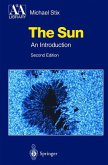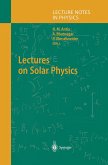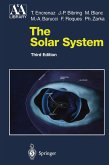Wie in allen anderen Gebieten der Astronomie haben instrumenteller Fortschritt und neue Beobachtungstechniken auch in der Sonnenphysik zahlreiche, neue Erkenntnisse gebracht und neue Fragen aufgeworfen. Die vorliegende Study Edition enthält einen vollständigen Überblick über den heutigen Wissensstand in der Sonnenphysik und ihre aktuellen Probleme.
Hinweis: Dieser Artikel kann nur an eine deutsche Lieferadresse ausgeliefert werden.
Hinweis: Dieser Artikel kann nur an eine deutsche Lieferadresse ausgeliefert werden.
From the reviews:
"This is the definitive book on the physics of the sun, and if that's your interest, then I can thoroughly recommend it." (C.R. Kitchin, Astronomy Now, June 2003)
"This is an excellent introduction to the whole of Solar physics at a consistent level of mathematics and assumed physics background. It would be suitable as a reference for some advance undergraduate courses and should be compulsory reading for postgraduate students studying the Sun. It could also be read with interest by anyone with a physics background wishing to learn more detail about the Sun than is available online or through general astrophysics books." (International Journal of Astrobiology, 2/1, 2003)
"The book from the Springer Astronomy and Astrophysics Library Series gives an introduction to the physics of the Sun. [...] From an amateur solar observer's perspective, there are many parts of the book which are of interest. [...] This book has been well produced with plenty of diagrams and photographs (with a view in colour) throughout." (The Astronomer, 39/465, 2003)
"This must-have book is of great value to every Sun specialist as well to students or graduates. Nearly each sub-chapter contains a small number of problems linked to the previous paragraphs, and this invitation to become a more active reader must be encouraged." (Physicalia 2005, 57, page 211-212)
From the reviews of the second edition:
"This book provides a solid and extremely readable introduction to the physics and the phenomenology of the solar interior and lower atmosphere ... . its status as a classic is well deserved. It is a delight to read, and I can recommend it strongly ... . the book is well presented and easy to use. It is amply and appropriately illustrated ... . The author conveniently includes bibliographic notes ... . will continue to be a basic reference text ... ." (Dr. L. Fletcher, Contemporary Physics, Vol. 46 (4), 2005)
"This is a serious introduction to solar physics. ... The maths is effectively aimed at the serious senior undergraduate or post graduate student. ... This second edition updates the original 1989 publication ... . It is essentially an advanced text book with problems set throughout. ... There is a much needed list of symbols ... list of references and a comprehensive index." (Roger Feasey, Journal of the Auckland Astronomical Society, December, 2004)
"The first edition, published in 1989, was excellent. It was clear, thorough, well illustrated and well referenced. ... The second edition is just as good and has been brought right up to date. ... The Sun is a member of Springer's highly commendable Astronomy and Astrophysics Library and is a first-class example of what a good textbook should be." (David W. Hughes, The Observatory, Vol. 124 (1183), 2004)
"This book is an introduction to the physics of the Sun ... . This must-have book is of great value to every Sun specialist as well as to students orgraduates. Nearly each sub-chapter contains a small number of problems linked to the previous paragraphs, and this invitation to become a more active reader must be encouraged." (Gaston Marrette, Physicalia, Vol. 57 (3), 2005)
"This is the definitive book on the physics of the sun, and if that's your interest, then I can thoroughly recommend it." (C.R. Kitchin, Astronomy Now, June 2003)
"This is an excellent introduction to the whole of Solar physics at a consistent level of mathematics and assumed physics background. It would be suitable as a reference for some advance undergraduate courses and should be compulsory reading for postgraduate students studying the Sun. It could also be read with interest by anyone with a physics background wishing to learn more detail about the Sun than is available online or through general astrophysics books." (International Journal of Astrobiology, 2/1, 2003)
"The book from the Springer Astronomy and Astrophysics Library Series gives an introduction to the physics of the Sun. [...] From an amateur solar observer's perspective, there are many parts of the book which are of interest. [...] This book has been well produced with plenty of diagrams and photographs (with a view in colour) throughout." (The Astronomer, 39/465, 2003)
"This must-have book is of great value to every Sun specialist as well to students or graduates. Nearly each sub-chapter contains a small number of problems linked to the previous paragraphs, and this invitation to become a more active reader must be encouraged." (Physicalia 2005, 57, page 211-212)
From the reviews of the second edition:
"This book provides a solid and extremely readable introduction to the physics and the phenomenology of the solar interior and lower atmosphere ... . its status as a classic is well deserved. It is a delight to read, and I can recommend it strongly ... . the book is well presented and easy to use. It is amply and appropriately illustrated ... . The author conveniently includes bibliographic notes ... . will continue to be a basic reference text ... ." (Dr. L. Fletcher, Contemporary Physics, Vol. 46 (4), 2005)
"This is a serious introduction to solar physics. ... The maths is effectively aimed at the serious senior undergraduate or post graduate student. ... This second edition updates the original 1989 publication ... . It is essentially an advanced text book with problems set throughout. ... There is a much needed list of symbols ... list of references and a comprehensive index." (Roger Feasey, Journal of the Auckland Astronomical Society, December, 2004)
"The first edition, published in 1989, was excellent. It was clear, thorough, well illustrated and well referenced. ... The second edition is just as good and has been brought right up to date. ... The Sun is a member of Springer's highly commendable Astronomy and Astrophysics Library and is a first-class example of what a good textbook should be." (David W. Hughes, The Observatory, Vol. 124 (1183), 2004)
"This book is an introduction to the physics of the Sun ... . This must-have book is of great value to every Sun specialist as well as to students orgraduates. Nearly each sub-chapter contains a small number of problems linked to the previous paragraphs, and this invitation to become a more active reader must be encouraged." (Gaston Marrette, Physicalia, Vol. 57 (3), 2005)








